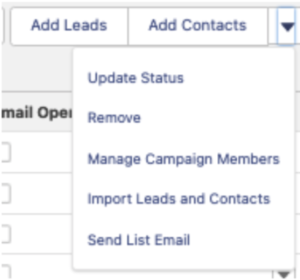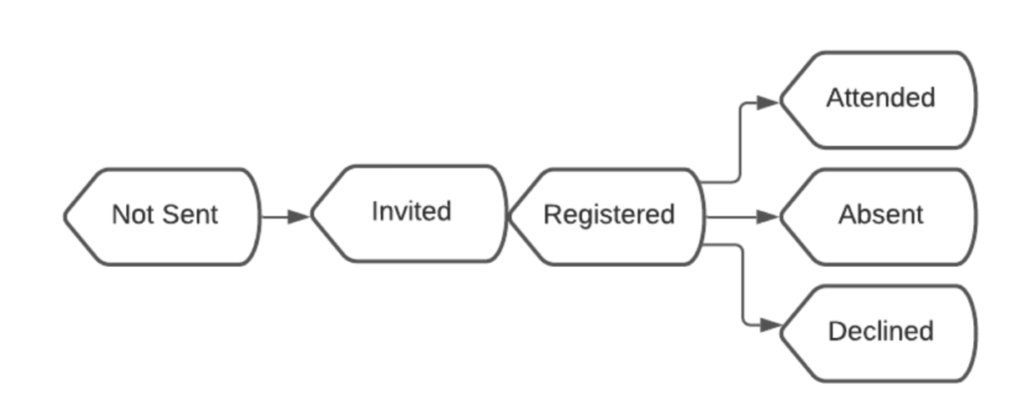Learning How to Use Salesforce Campaigns
A Campaign is an “object” that allows Salesforce to track and measure the performance of marketing activity or buckets of activities promoting a product or service. Campaigns are comprised of the individual target subject “Campaign Members” (typically Leads and Contacts), and an associated “Campaign Member Status,” that may or may not display the funnel stage of each target member.
Similar to other Salesforce objects, Campaigns are populated by records with associated fields. Campaigns may have various record types, a parent/child relationship with other campaigns (called a “Campaign Hierarchy,”) and an associated cost which may be used to determine ROI.
*Be careful not to confuse the Salesforce Campaign object with a marketing campaign initiative. Salesforce Campaigns are structured within the standard Salesforce data model; and while there is sure to be some overlap, a marketing campaign initiative will not necessarily correspond to fit neatly into Salesforce, and a Salesforce Campaign is not configured out-of-the-box to align with any specific initiative.
Campaign Record Types
Record Types allow different page layouts with different fields, with different picklist values, customized for each category of initiative. For example, an email Record Type may display template or email KPIs, an advertisement Record Type may show impressions, clicks or web conversions, whereas an event Record Type may display location, timing or platform. Record types are incredibly customizable, but are very infrequently used, as significant customization manual data entry is often required to make Campaigns useful. However, many third-party platforms (such as Pardot or many email / event platforms) utilize native Salesforce integration and populate record type data.
Campaign Hierarchy

Leads, Contacts, Converted Leads, Opportunities and Won Opportunities may be viewed at the child level (individual campaign), parent level (a rollup of all children), or grandparent (a rollup of all parents and children). This allows campaign effectiveness, and a Campaign’s impact to be measured across the entire marketing to sales funnel. Campaign performance may be viewed by a specific initiative and simultaneously rolled up to an overarching strategic initiative.
Campaign Hierarchy Strategies
Campaign Hierarchies are used primarily for reporting. As a result, the top level (Parent or Grandparent) Campaign should correspond to the largest bucket of reporting that the business needs to measure performance. Salesforce identifies a couple very helpful top level examples, including
1. Regions,
2. Product / Service Verticals, 3. Calendar years, 4. Or overarching goals:
Using this methodology, individual initiatives or asset engagement (emails, landing pages) performance can be measured independently, and also rolled up as part of the broader initiative they support, as well as the overarching Campaign goal, geo, brand or date-range.
*There is no right way to build a Campaign Hierarchy; only what makes the most sense to surface the most important data, which is different for every different business.
Campaign Member Status
Campaign Member Status allows for leads and contacts to be tracked throughout a marketing funnel of the Campaign, and attributed to a particular phase of an initiative (in addition to a potentially fixed Lead Souce). However, Salesforce only offers a couple out-of-the box statuses, typically “Send” and “Responded.” This may make sense for an email about a content download, where the three stages of the funnel are 1. Sent email, 2. Engaged with email, and 3. Downloaded content.
However, real-life campaigns are often far more complex, which require numerous custom member statuses. For example, an event Campaign funnel might look more like this:
In this example, Campaign Member Statuses must be created as per the funnel stages of the event. For more information about creating custom Campaign Member Statuses, check out Salesforce’s Guide to Campaign Member Status .
When creating Salesforce Campaigns, there are three steps to creating Campaign Member Statuses
- Consider the types of marketing initiatives the business runs. These can be applied to Campaign Hierarchy or Campaign Record Types (which offer the possibility of different Salesforce Page Layouts).
- Map out every outcome Every possible marketing journey touchpoint (that needs to be measured) should be mapped to a Campaign Member Status
- Define Success Articulate the ultimate goal of the particular campaign. What is the purpose of the campaign, and what Member Status should correspond to a Lead or Contact reaching that status?
Adding Lead + Contacts to Salesforce Campaigns + Updating Member Status

Manual / Import:
In Salesforce, on the Campaign record in the details tab will be the “Campaign Members” list view. There are two buttons “Add Leads” and “Add Contacts” that will allow Salesforce marketing users to query and select records of each type to the Campaign. The “Import Leads and Contacts” button dropdown links to Salesforce’s “Data Import Wizard” to add Campaign Membership in bulk via CSV. The “Campaign Members” list view may also be used to select members and change Campaign Member Status manually via multi-select and the “Update Status” Button.
Automation with Pardot:
Pardot customers may use Pardot to automatically add prospects (Leads and Contacts) to campaigns and adjust Campaign Member Status, using Pardot imports and automations. Like Salesforce, Campaign Membership and Status will not update automatically unless the Prospect is newly added to a campaign even when using Pardot Connected Campaigns.
*note: All Pardot assets are required to be associated with a primary Campaign (Email Templates, Landing Pages and Prospects).
The most common way to use Pardot to add prospects to Campaigns is via the automation tool Completion Action. Completion Actions may be applied as result of a successful Form or Form Handler Completion, Page Action, Custom Redirect or email interaction.

Similarly, Engagement Studio “Actions” and Automation Rules may be used to add prospects to Campaigns, or adjust Campaign Status based on a specific journey, or certain rule criteria being met. As an example, an Engagement Studio program may be configured to add new prospects to a Campaign (perhaps as a result of a Dynamic List), then change Campaign Member Status progressively over the course of the program depending on what the prospect does using Engagement Studio “Triggers” and “Rules.”
*As a best practice, Campaigns should be configured with all possible Statuses before planning automation. Order of operations is crucial to successful Campaign planning.
Campaign Naming Conventions
As Salesforce Campaign usage proliferates throughout the business, the importance of clearly defined, consistent and descriptive naming conventions will become crucial to organization and the ability to report on campaigns.
Consistency: Consider creating a Campaign naming template, with specific required variables and articulated delimiters. For example, using the consistent format YEAR.MONTH.DAY|CHANNEL|NAME|AUDIENCE|GOAL|VERSION makes all campaigns sortable and exportable.
Descriptive: Similarly, think about who in the business will interact with the Campaign Object. If Campaign will be used in firmwide reporting, consider identifying attributes in the title that describe the what, why, who and when of the Campaign.
*Many firms use Campaign Hierarchy and naming conventions to mirror Pardot Folder Structure. As Folder Structure may also be used for reporting (see Scoring Categories), choosing to align Campaigns and Folders can be very helpful to long-term organization and reporting.
Campaign Influence
Another benefit of Salesforce Campaign hierarchy is that Leads + Contacts may have a one-to-many relationship with Campaigns. As opposed to traditional attribution model (i.e. legacy Pardot “first-touch” or Google Ads default “last-touch”), Campaign Hierarchies allow prospects to be part of one or more Campaigns, allowing Salesforce to do basic multi-touch attribution. Though this feature must be configured by a Salesforce admin, customizable Campaign Influence uses Campaign Hierarchy to be able to contrast First Touch, Even-Distribution or Last-Touch models.
Understanding how engagement impacts purchasing decisions requires configuring how marketing cost / sales = ROI. Technically, every campaign should have a budgeted cost and campaign members progressing through a marketing funnel (MQL).
In the traditional Salesforce data model, Leads are “converted” to Contacts, with an associated Account and Opportunity, which typically contains an Amount field.
Setting up Campaign Influence is an advanced Pardot feature, that only functions based on a robust Campaign Hierarchy, and which must be configured by a Salesforce Admin.
Summary
Campaigns are a powerful yet nuanced Salesforce object l that can help measure, streamline and optimize marketing efforts. Using Campaign features like Hierarchies, Member Statuses and consistent naming conventions creates deeper visibility into the performance of larger marketing campaigns. If utilized properly, Campaigns can show which marketing efforts generated Leads, drove Contact / Opportunity conversions and most importantly, led to revenue. Reporting on campaigns can help adjust existing marketing campaigns, and make more effective future marketing decisions.





